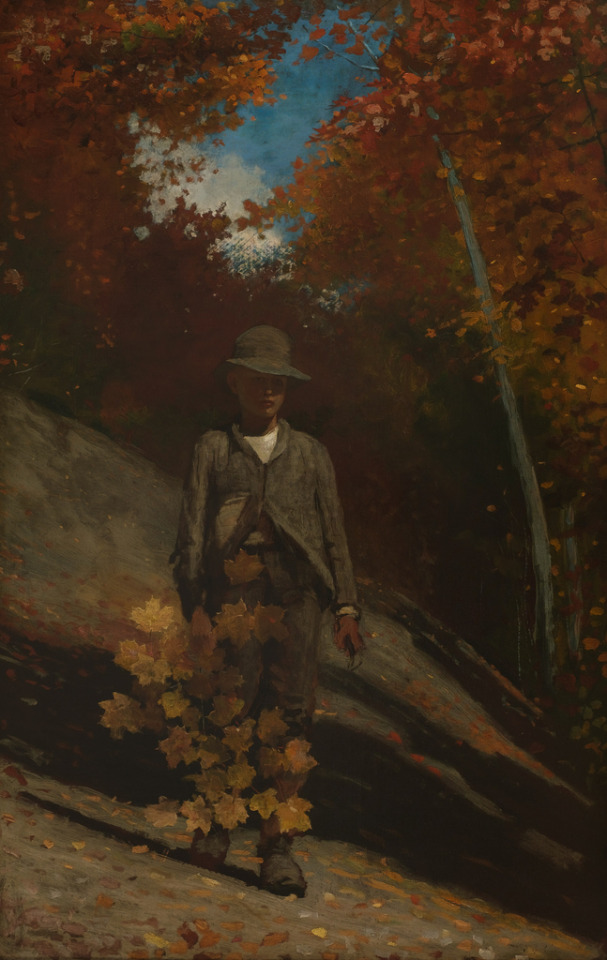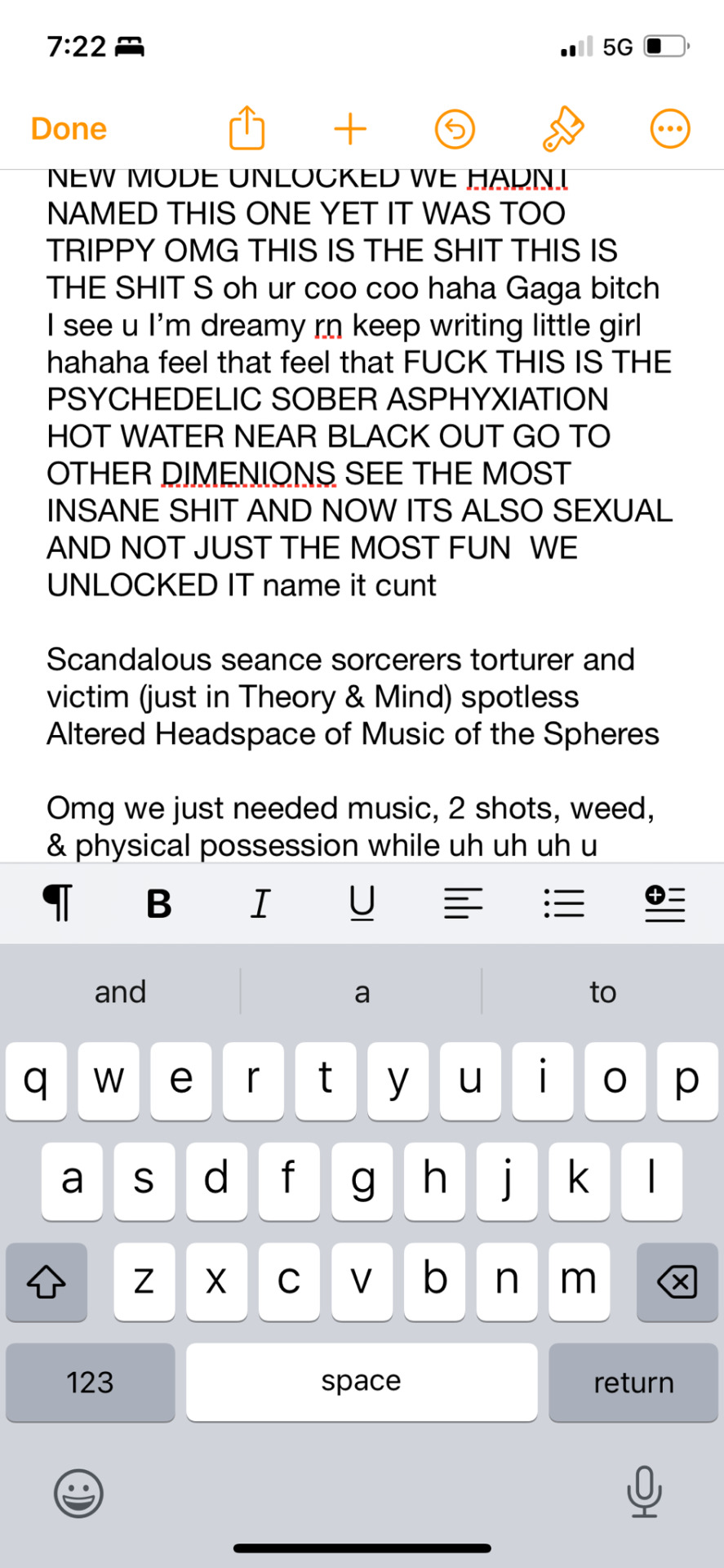Text

Gathering Autumn Leaves, Winslow Homer, ca. 1877
408 notes
·
View notes
Text
Taking two years to take research notes and make sketches, will live off 435$ a month, (my rent is paid for thru city funding for mentally ill) until I save money for transcribing software. Then two years to save money for bike or Ubers, to get back to grad school. I think two years of research and dreaming and meditation and taking care of myself is just what the Doctor ordered.
💕🖤💕🌌💕🌌🖤💕
0 notes
Text
0 notes
Text
Katherine Nonemaker
ARTH Towson University
Dr Susan Isaacs
Image 1: Pablo Picasso
Guernica, 1937
137.4 x 305.5 in
Oil on canvas
Image 2: Henri Matisse
The Dance, Summer 1932 – April 1933
Overall (left): 133 ¾ x 173 ¾ in. Overall (center): 140 1/8 x 198 1/8 in. Overall (right): 133 3/8 x 173 in.
Oil on canvas
These two works are similar in scale, each with stylized figures, but that is where their similarities end. Pablo Picasso’s Guernica is a powerful statement on the atrocities of war, specifically the April 27, 1937 bombing of Guernica, a town in Spain. The attack was carried out by Francisco Franco and his allies – the German Nazis and the fascist Italians. The attack was the very first aerial bombing of a civilian city, a “city with no strategic military value,” as stated by Lynn Robinson in an article about Guernica and its history. After 3 hours of bombing, the city lay in flaming ruins, and survivors attempting to flee were shot down by 20 German planes. A third of the population was killed or injured by this “training mission.”
Picasso had been commissioned by the Spanish Republican government in 1936 to create a painting for the 1937 Paris World Fair. Even though Picasso’s work had never been political, he felt moved by the news of the Guernica attack to create a memorial painting portraying the horrors of the bombing. In stark black, grey, and white, Picasso paints a scene of death and pain, with animals and figures screaming. Influenced by his Cubist work, the figures are flattened and faceted, breaking into pieces.
Painted in only a month, after hundreds of sketches, the painting was shown at the World Fair where it reached an audience of millions. It was then toured internationally, supported by the Spanish Republicans, to raise awareness and funding for Spanish refugees. Picasso stated that as long as Franco ruled, he did not want the painting to reside in Spain. When the Republican party was reestablished in 1981, Guernica found its way to the national museum of modern art in Madrid, Spain - the Reina Sofia - where it is permanently housed. The work continues to be a political image utilized by contemporary artists to raise awareness for other atrocities of war, such as the American bombing of Iraq.
The Dance by Henri Matisse is a large mural comprised of three canvas panels, painted in oil. The work is a variation on a theme, as Matisse created several paintings titled The Dance, each featuring uninhibited nude figures dancing together. The first version was painted two decades before the mural. This version of The Dance was commissioned by Dr. Albert C. Barnes of the Barnes Foundation in Philadelphia, Pennsylvania. Dr. Barnes wished to fill the large arches of his home with a mural, and Matisse complied. The work is brightly colored, with the figures silhouetted against a bright blue and salmon pink geometric background. Matisse worked on the piece for over a year. The Dance is joyful and exuberant, with a great sense of playfulness through the choice of color.
The Dance is primarily an aesthetic experience, a celebration of the human figure and its expression in dance. Guernica is a dramatic commentary on the atrocities of war, with imagery of death and destruction. The works represent art’s ability to conjure a mood or emotion in the viewer, whether that is one of joy, such as in The Dance, or horror, such as when viewing the shattered and jagged imagery of Guernica. These powerful emotional dualities are made manifest in these two works.
1 note
·
View note
Text
Katherine Nonemaker
ARTH Towson University
Dr Susan Isaacs
Image 1: Yves Klein
Anthropology of the Blue Epoch, 1960
Image 2: Eva Hesse
Tori, 1969
47 x 17 x 15 in, polyester, resin, and fiberglass on wire mesh
Image 3: Joseph Kosuth
One and Three Chairs, 1965
Wood folding chair, mounted photographs
Image 4: Christo and Jeanne – Claud
Running Fence, 1972-1976
Sonoma and Marin Counties, California
Yves Klein and Eva Hesse were two incredibly important artists working in the fifties and sixties, both of whom pushed the boundaries of minimalism and influenced the new realms of conceptual and installation art. Klein, a French artist, was making monochrome paintings starting in 1947, creating almost 200 all-blue paintings made with what the artist called “International Klein Blue.” IKB was a color that Klein created with the help of a chemist - the indigo tinted blue of a sky beginning to darken. Klein felt that the vibrating blue signified boundlessness, cosmic energy, and the infinite Void. Klein had experimented with a variety of monochromatic paintings, searching for the perfect color before he struck on his vivid blue. He was interested in the “immaterial,” a sense of spirituality and universal truth.
Anthropology of the Blue Epoch is a work featuring IKB, but instead of a roller or brushes, Klein directed a female model to use her body to apply the paint to the surface of the canvas. In his 1960 performance piece The Monotone Symphony, Klein, in black tie and immaculate white gloves, conducted a 20-piece orchestra while three nude female models covered themselves in IKB from buckets on the floor, and then dragged and pressed their bodies to canvas or paper as the orchestra played a single sustained note. The result was works like Anthropology – paintings that were energetic and alive. Here, the image becomes a symbol for the action of the model…her movements captured through the electric blue. In an interview with curators from the Walker Art Center, we hear a quote from Bachelard: “…first there is nothing, then there is a deep nothing, and beyond that there is a deep blue.”
Eva Hesse started her career as an Abstract Expressionist, moving towards minimalism in her geometric paintings from the 50s. She studied at Yale under Joseph Albers, but her focus shifted from painting and drawing to sculpture after a 15-month residency in Germany with her husband Tom Doyle, a sculptor. She began to experiment with new and innovative materials including rubber, steel, and plastics. Good friends with minimalists Sol LeWitt and Don Judd, Hesse’s work might be defined as post-minimalism. Tori is a series of multiples, a hallmark of pop and minimalism, where the hand of the artist is largely erased. The sculptures, yellowed with age now, exhibit a kind of gravity and softness. Hesse’s sculptures are organic and biomorphic, a sharp contrast to the sleek and geometric work of LeWitt and Judd.
Hesse tragically died of a brain tumor at the age of 34 in 1970, an illness that was most likely caused by handling dangerous materials when she was creating her sculpture in the abandoned textile warehouse in which she kept her studio. Klein also died at age 34, of a heart attack. Klein’s widow says in an interview that ten minutes before he died, he stated that “I’ll have the biggest studio in the world, that can be considered as space to work intensely.”
The next image in this series, One and Three Chairs is a conceptual work by Joseph Kosuth, another incredibly influential artist working in the sixties. One and Three Chairs is comment on the work of Derrida, and an introductory illustration of semiotics. While the arrangement of objects in the work has a minimalist sensibility, the point of the work is the idea. One and Three Chairs references a previous work of Kosuth’s, the influential piece Art as Idea as Idea, borrowing the blown up photostat of a dictionary entry – “Chair.” Conceptual art was a direct reaction to the individualistic and emotional qualities of Abstract Expressionism – the application of paint to a surface was no longer relevant, while the pure realm of idea took hold. These conceptual installations by Kosuth influenced generations of new artists working in conceptual art.
Christo and Jean-Claude’s monumental work Running Fence is a 24-mile long temporary installation of a nylon fence spanning California’s Sonoma and Marin Counties. These husband and wife collaborators create ephemeral site-specific sculpture that change a landscape and contributes a sense of dynamism and composition. They are not interested in permanency. Workers are hired by the duo to help erect their temporary works, and in this way it becomes a community project. Running Fence is experiential, a monument, a temporary awe. The work is an example of New Realism, where artists used real objects in their work rather than representation in paint on canvas. They preferred to create tactile works that could be physically touched. These two works, One and Three Chairs and Running Fence, one intellectual, one a monumental experience of temporality, each demonstrate a unique dedication to innovative forms of art making that influenced later generations of artists.
0 notes
Text
Katherine Nonemaker
ARTH Towson University
Dr Susan Isaacs
Image 1: Yves Klein
Anthropology of the Blue Epoch, 1960
Image 2: Eva Hesse
Tori, 1969
47 x 17 x 15 in, polyester, resin, and fiberglass on wire mesh
Image 3: Joseph Kosuth
One and Three Chairs, 1965
Wood folding chair, mounted photographs
Image 4: Christo and Jeanne – Claud
Running Fence, 1972-1976
Sonoma and Marin Counties, California
Yves Klein and Eva Hesse were two incredibly important artists working in the fifties and sixties, both of whom pushed the boundaries of minimalism and influenced the new realms of conceptual and installation art. Klein, a French artist, was making monochrome paintings starting in 1947, creating almost 200 all-blue paintings made with what the artist called “International Klein Blue.” IKB was a color that Klein created with the help of a chemist - the indigo tinted blue of a sky beginning to darken. Klein felt that the vibrating blue signified boundlessness, cosmic energy, and the infinite Void. Klein had experimented with a variety of monochromatic paintings, searching for the perfect color before he struck on his vivid blue. He was interested in the “immaterial,” a sense of spirituality and universal truth.
Anthropology of the Blue Epoch is a work featuring IKB, but instead of a roller or brushes, Klein directed a female model to use her body to apply the paint to the surface of the canvas. In his 1960 performance piece The Monotone Symphony, Klein, in black tie and immaculate white gloves, conducted a 20-piece orchestra while three nude female models covered themselves in IKB from buckets on the floor, and then dragged and pressed their bodies to canvas or paper as the orchestra played a single sustained note. The result was works like Anthropology – paintings that were energetic and alive. Here, the image becomes a symbol for the action of the model…her movements captured through the electric blue. In an interview with curators from the Walker Art Center, we hear a quote from Bachelard: “…first there is nothing, then there is a deep nothing, and beyond that there is a deep blue.”
Eva Hesse started her career as an Abstract Expressionist, moving towards minimalism in her geometric paintings from the 50s. She studied at Yale under Joseph Albers, but her focus shifted from painting and drawing to sculpture after a 15-month residency in Germany with her husband Tom Doyle, a sculptor. She began to experiment with new and innovative materials including rubber, steel, and plastics. Good friends with minimalists Sol LeWitt and Don Judd, Hesse’s work might be defined as post-minimalism. Tori is a series of multiples, a hallmark of pop and minimalism, where the hand of the artist is largely erased. The sculptures, yellowed with age now, exhibit a kind of gravity and softness. Hesse’s sculptures are organic and biomorphic, a sharp contrast to the sleek and geometric work of LeWitt and Judd.
Hesse tragically died of a brain tumor at the age of 34 in 1970, an illness that was most likely caused by handling dangerous materials when she was creating her sculpture in the abandoned textile warehouse in which she kept her studio. Klein also died at age 34, of a heart attack. Klein’s widow says in an interview that ten minutes before he died, he stated that “I’ll have the biggest studio in the world, that can be considered as space to work intensely.”
The next image in this series, One and Three Chairs is a conceptual work by Joseph Kosuth, another incredibly influential artist working in the sixties. One and Three Chairs is comment on the work of Derrida, and an introductory illustration of semiotics. While the arrangement of objects in the work has a minimalist sensibility, the point of the work is the idea. One and Three Chairs references a previous work of Kosuth’s, the influential piece Art as Idea as Idea, borrowing the use of a blown up photostat of a dictionary entry – “Chair.” Conceptual art was a direct reaction to the individualistic and emotional qualities of Abstract Expressionism – the application of paint to a surface was no longer relevant, while the pure realm of idea took hold. These conceptual installations by Kosuth influenced generations of new artists working in conceptual art.
Christo and Jean-Claude’s monumental work Running Fence is a 24-mile long temporary installation of a nylon fence spanning California’s Sonoma and Marin Counties. These husband and wife collaborators create ephemeral site-specific sculpture that change a landscape and contributes a sense of dynamism and composition. They are not interested in permanency. Workers are hired by the duo to help erect their temporary works, and in this way it becomes a community project. Running Fence is experiential, a monument, a temporary awe. The work is an example of New Realism, where artists used real objects in their work rather than representation in paint on canvas. They preferred to create tactile works that could be physically touched. These two works, One and Three Chairs and Running Fence, one intellectual, one a monumental experience of temporality, each demonstrate a unique dedication to innovative forms of art making that influenced later generations of artists.
0 notes
Text
Da da I just squirted for the first time when You said You Came.
We both wanna show off by talking about it over my whackadoo Schizo texts but this will do now.
619 PUT UR HANDS UP HIGH
Hell (6) Unity (1) Heaven for Infinity (9) (for the Dual Serpent)
0 notes
Text
youtube
Singing to Da da
Hahaha I make the same sounds to Sound as he does when he jerks off to Watching me on His phone
0 notes






















